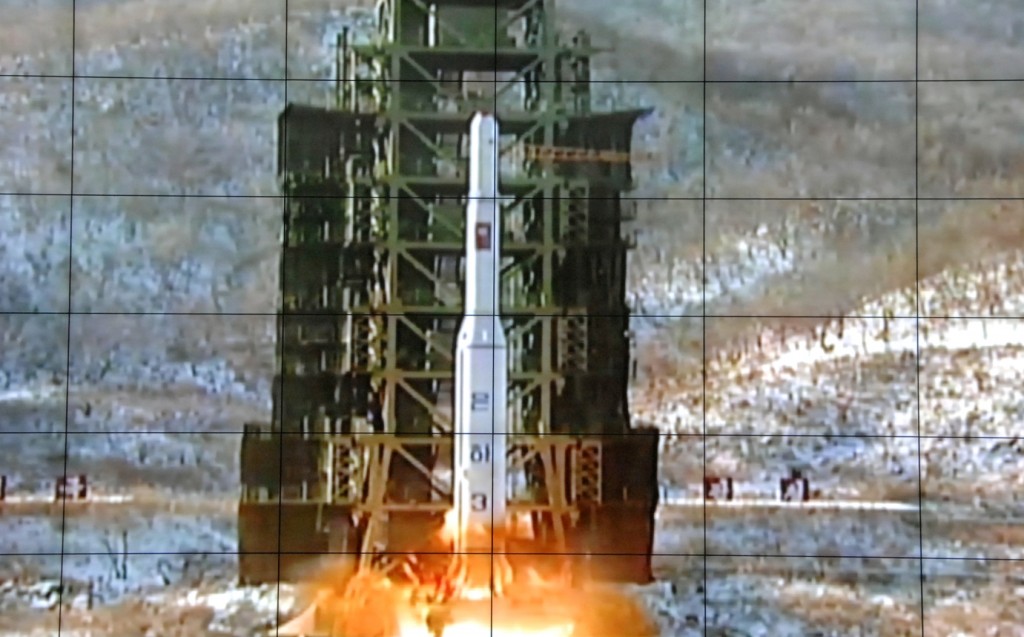- California Assembly OKs highest minimum wage in nation
- S. Korea unveils first graphic cigarette warnings
- US joins with South Korea, Japan in bid to deter North Korea
- LPGA golfer Chun In-gee finally back in action
- S. Korea won’t be top seed in final World Cup qualification round
- US men’s soccer misses 2nd straight Olympics
- US back on track in qualifying with 4-0 win over Guatemala
- High-intensity workout injuries spawn cottage industry
- CDC expands range of Zika mosquitoes into parts of Northeast
- Who knew? ‘The Walking Dead’ is helping families connect
N. Korea tells UN agencies it will launch satellite this month

This December 2012 photo, released by North Korea’s official Korean Central News Agency, shows North Korea’s Unha-3 rocket being fired from the Sohae Satellite Launching Station in Cholsan, North Pyongan Province. (Yonhap)
SEOUL, South Korea (AP) — Weeks after its fourth nuclear test, North Korea announced plans Tuesday to launch an Earth observation satellite on a rocket later this month, in what critics see as a covert test of banned technology for a ballistic missile that could strike the U.S. mainland.
An official at the London-based International Maritime Organization said North Korea declared that the launch would be conducted between Feb. 8 and 25, between 7 a.m. and noon Pyongyang time. The official spoke on condition of anonymity because she hadn’t been authorized to speak publicly yet.
U.N. deputy spokesman Farhan Haq said North Korea also informed the International Civil Aviation Organization and the International Telecommunication Union of the planned satellite launch.
The International Telecommunication Union said North Korea also informed its Geneva office of its intention to launch a Kwangmyongsong (Bright Star) -type Earth observation satellite with a four-year operational life. But the ITU’s U.N. representative, Gary Fowlie, said not enough technical information had been supplied to register the planned launch in its Master International Frequency Register.
In Washington, Daniel Russel, the top diplomat for East Asia, said the U.S. was closely tracking reports of the North’s planned launch. He said a launch that uses ballistic missile technology would be another violation of a U.N. ban and strengthens the argument for the international community to impose “real consequences” on North Korea for destabilizing behavior. He called for the imposition of tough additional sanctions.
Russel said a launch “would be an unmistakable slap in face to those who argue that you just need to show patience and dialogue with the North Koreans but not sanctions,” in an apparent reference to China.
A South Korean official, who spoke on condition of anonymity because of office rules, said Seoul was also informed of the plans, and estimated that the first stage of the rocket would fall off the west coast of South Korea, more debris would land near the South’s Jeju Island, and the second stage would land off the Philippines’ east coast.
North Korea’s last long-range rocket launch, in December 2012, was seen as having successfully put the country’s first satellite into orbit after a string of failures. The North also told international agencies before that launch of its plans. Each new rocket launch improves North Korea’s missile technology, which is crucial for its goal of developing a nuclear-armed missile capable of hitting the U.S. mainland.
North Korea, an autocracy run by the same family since 1948, is estimated to have a handful of crude nuclear devices and an impressive array of short- and medium-range missiles, but it closely guards details about its nuclear and missile programs. This means there is considerable debate by outsiders about whether it can produce nuclear bombs small enough to place on a missile, or missiles that can reliably deliver their bombs to faraway targets.
North Korea has spent decades trying to develop operational nuclear weapons. It calls its rocket launches satellite missions, but the U.N., the United States, South Korea and others say they are meant to test ballistic missile technology. The U.N. Security Council prohibits North Korea from nuclear and ballistic missile activity.
The North’s Jan. 6 nuclear test has led to another push in the U.N. to tighten sanctions, something that followed North Korea’s 2012 rocket launch and its 2013 third nuclear test. The North followed that test with an escalating campaign of bombast that included threats to fire nuclear missiles at the United States and South Korea.
North Korea has said that plutonium and highly enriched uranium facilities at its main Nyongbyon nuclear complex are in operation and that its scientists have improved “the levels of nuclear weapons with various missions in quality and quantity.”
But just what is happening at Nyongbyon is unclear. North Korea booted out international inspectors in 2009, and independent assessments by outside experts since then have been spotty.
___
Associated Press writers Foster Klug in Seoul, South Korea, Edith M. Lederer at the United Nations and Matthew Pennington in Washington contributed to this report.
















t--t.info
February 4, 2016 at 2:35 PM
Monster Jobs – Job Search, Career Advice & Hiring …